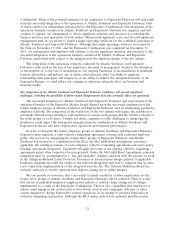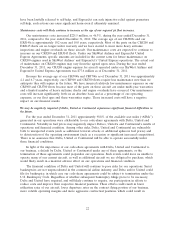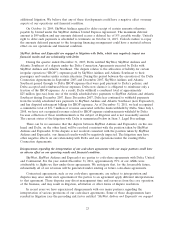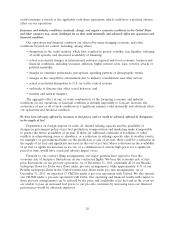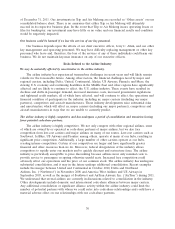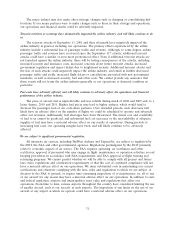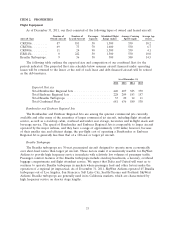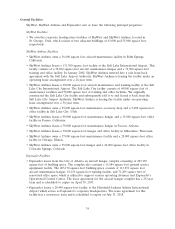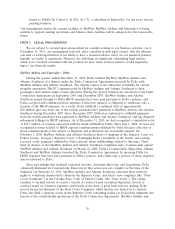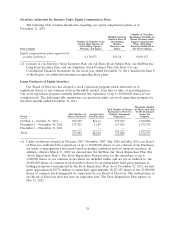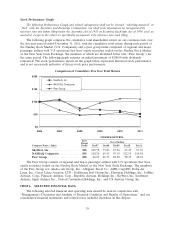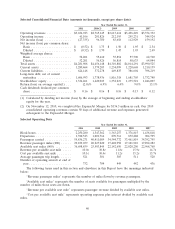SkyWest Airlines 2011 Annual Report Download - page 34
Download and view the complete annual report
Please find page 34 of the 2011 SkyWest Airlines annual report below. You can navigate through the pages in the report by either clicking on the pages listed below, or by using the keyword search tool below to find specific information within the annual report.of December 31, 2011. Our investments in Trip and Air Mekong are recorded as ‘‘Other assets’’ on our
consolidated balance sheet. There is no assurance that either Trip or Air Mekong will ultimately
succeed in its respective business plan. In the event that Trip or Air Mekong incurs operating losses or
files for bankruptcy, our investment may have little or no value and our financial results and condition
would be negatively impacted.
Our business could be harmed if we lose the services of our key personnel.
Our business depends upon the efforts of our chief executive officer, Jerry C. Atkin, and our other
key management and operating personnel. We may have difficulty replacing management or other key
personnel who leave and, therefore, the loss of the services of any of these individuals could harm our
business. We do not maintain key-man insurance on any of our executive officers.
Risks Related to the Airline Industry
We may be materially affected by uncertainties in the airline industry.
The airline industry has experienced tremendous challenges in recent years and will likely remain
volatile for the foreseeable future. Among other factors, the financial challenges faced by major and
regional carriers, including Delta, United, Continental, Alaska, US Airways, Pinnacle and Mesa, the
slowing U.S. economy and continuing hostilities in the Middle East and other regions have significantly
affected, and are likely to continue to affect, the U.S. airline industry. These events have resulted in
declines and shifts in passenger demand, increased insurance costs, increased government regulations
and tightened credit markets, all of which have affected, and will continue to affect, the operations and
financial condition of participants in the industry, including us, major carriers (including our major
partners), competitors and aircraft manufacturers. These industry developments raise substantial risks
and uncertainties, which will affect us, major carriers (including our major partners), competitors and
aircraft manufacturers in ways that we are unable to currently predict.
The airline industry is highly competitive and has undergone a period of consolidation and transition leaving
fewer potential code-share partners.
The airline industry is highly competitive. We not only compete with other regional airlines, some
of which are owned by or operated as code-share partners of major airlines, but we also face
competition from low-cost carriers and major airlines on many of our routes. Low-cost carriers such as
Southwest, JetBlue, US Airways and Frontier among others, operate at many of our hubs, resulting in
significant price competition. Additionally, a large number of other carriers operate at our hubs,
creating intense competition. Certain of our competitors are larger and have significantly greater
financial and other resources than we do. Moreover, federal deregulation of the industry allows
competitors to rapidly enter our markets and to quickly discount and restructure fares. The airline
industry is particularly susceptible to price discounting because airlines incur only nominal costs to
provide service to passengers occupying otherwise unsold seats. Increased fare competition could
adversely affect our operations and the price of our common stock. The airline industry has undergone
substantial consolidation, and it may in the future undergo additional consolidation. Recent examples
include the merger between United and Continental in October 2010, Delta and Northwest
Airlines, Inc. (‘‘Northwest’’) in November 2008 and America West Airlines and US Airways in
September 2005, as well as the merger of Southwest and AirTran Airways, Inc. (‘‘AirTran’’) during 2011.
We understand that several airlines are currently in discussions related to consolidation in the industry.
Other developments include domestic and international code-share alliances between major carriers.
Any additional consolidation or significant alliance activity within the airline industry could limit the
number of potential partners with whom we could enter into code-share relationships and could have a
material adverse effect on our relationships with our code-share partners.
30



